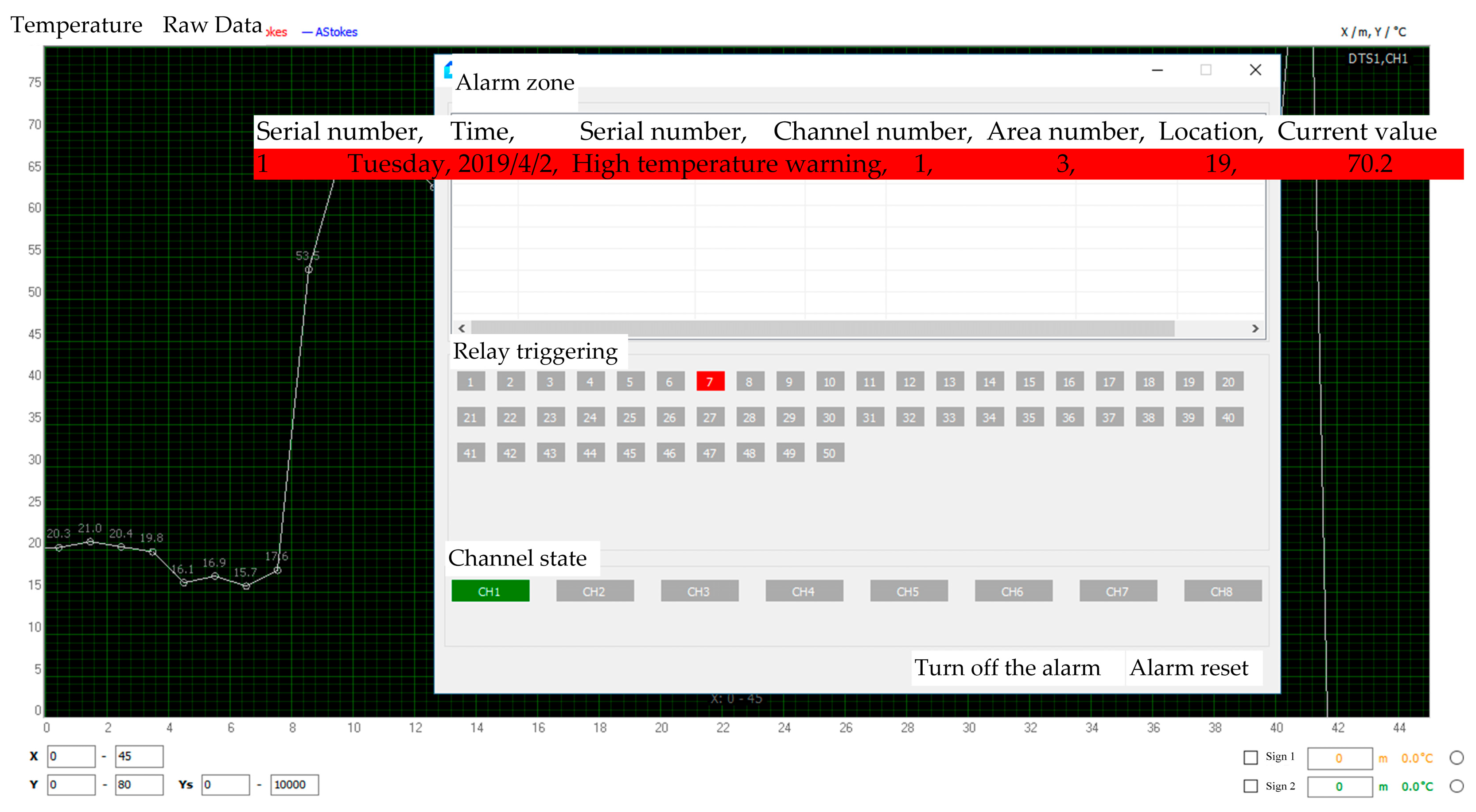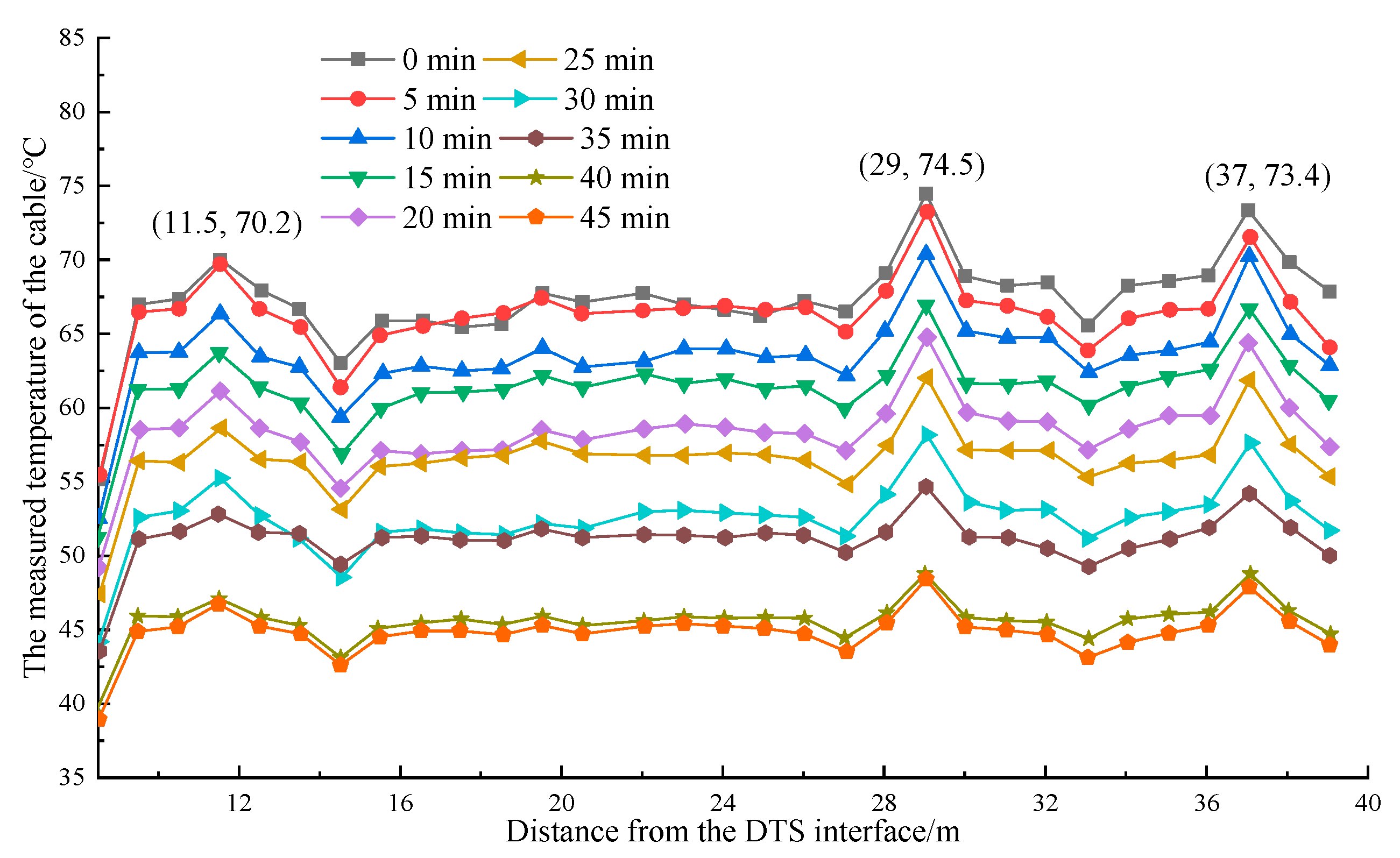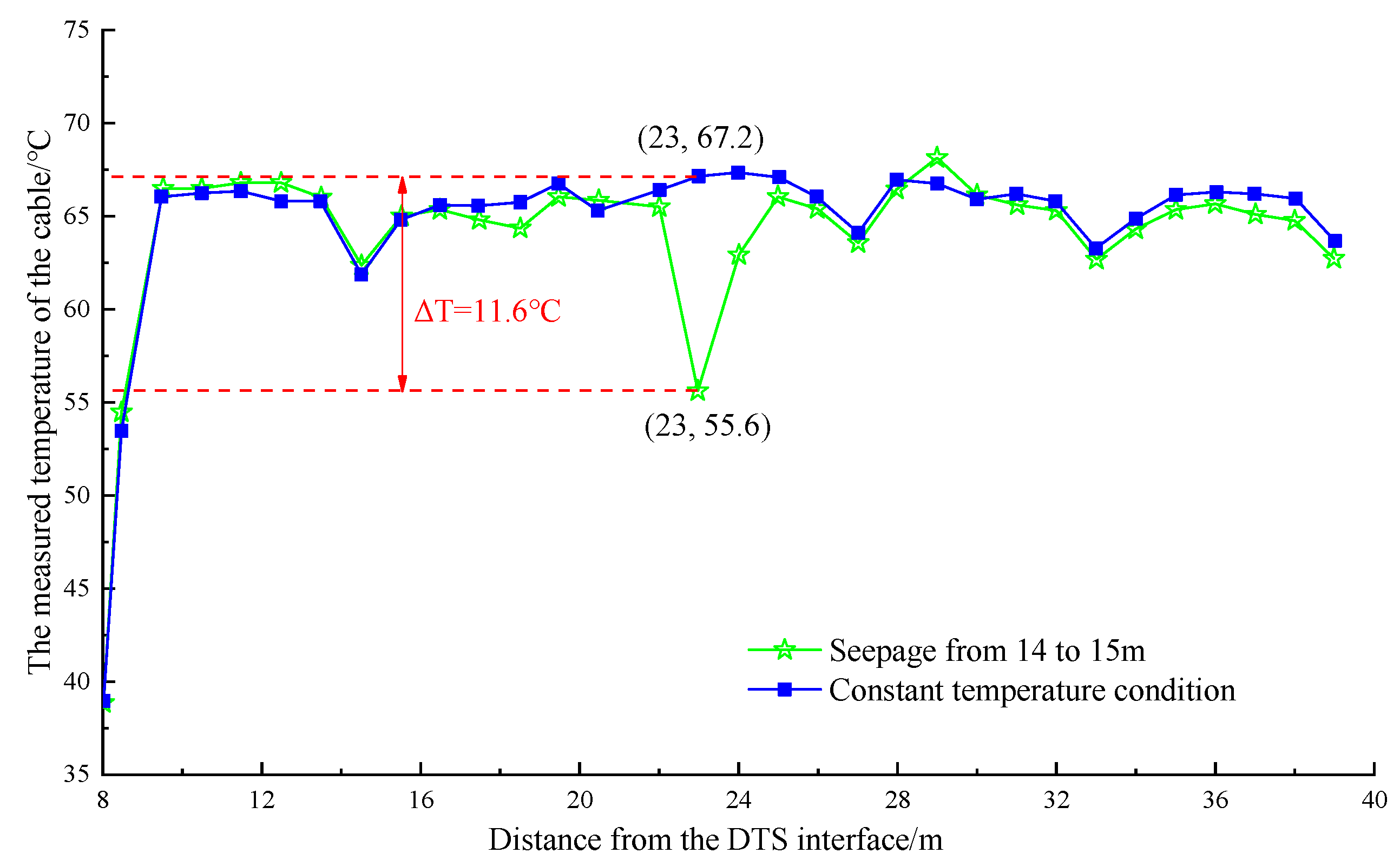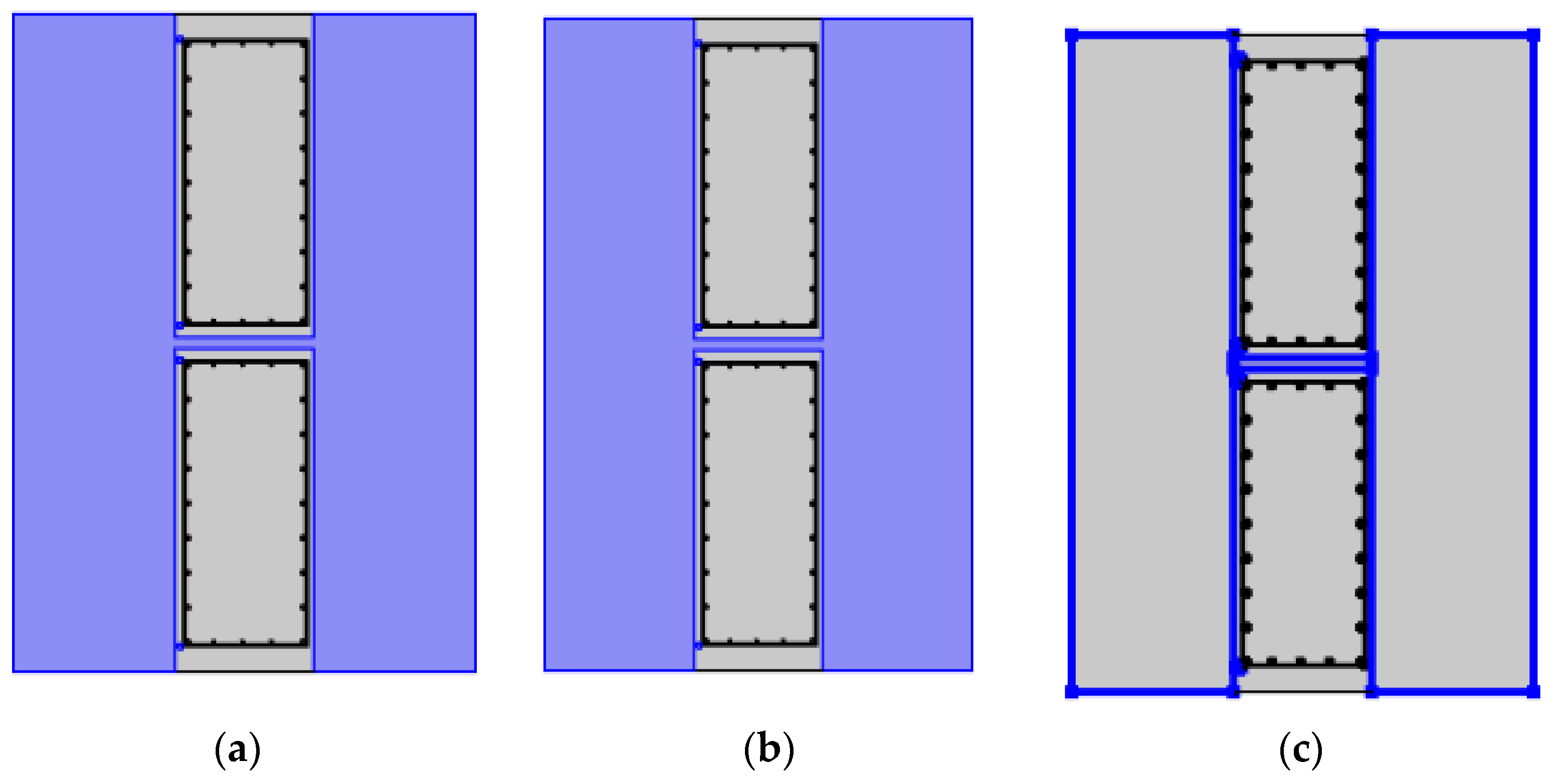Conceptual Model, Experiment and Numerical Simulation of Diaphragm Wall Leakage Detection Using Distributed Optical Fiber
Abstract
:1. Introduction
- (1)
- The detection efficiency was low, the workload was large, and the information feedback cycle was long.
- (2)
- The accuracy of the test results was poor and the subjectivity was strong, which required the theoretical background and experience of the test personnel.
- (3)
- The detection results were limited to the surface of the structure and could not reflect the water leakage inside the structure.
- (4)
- The detection time was narrow, so the detection time should be staggered with operation hours.
2. Conceptual Model
3. Distributed Optical Fiber Leakage Simulation Test
3.1. Test Instruments
3.1.1. Temperature Measuring Instrument
3.1.2. Optical Fiber Temperature Measurement System
3.2. Direct Device Ground Connection Test
3.2.1. Ground Heating System Connection
3.2.2. Simulated Leakage Condition
- (1)
- Abnormal detection of multistage heating and cooling
- (2)
- Multi-section abnormal temperature detection
3.3. Analysis of Test Results
3.3.1. Analysis of DTS Temperature Alarm Sensitivity and Temperature Measurement Characteristics
3.3.2. Analysis of Abnormal Temperature Rise and Fall
3.3.3. Analysis of Abnormal Constant Temperature
4. Numerical Experimental Analysis of the Active Temperature Field Leak Detection Method
4.1. Principles of Numerical Modeling
4.1.1. Introduction to COMSOL Software and Conjugate Heat Transfer Module
4.1.2. Numerical Simulation in Actual Working Conditions
4.1.3. Establishment of the Model
- (1)
- Heat transfer interface
- (2)
- Laminar flow interface
- (3)
- Non-isothermal flow interface
4.2. Numerical Simulation Results
5. Field Operation of Distributed Optical Fiber Leak Detection in Foundation Pit Engineering
5.1. Site Construction Overview and Engineering Geological Conditions
5.2. Design of Leakage Detection Scheme for Diaphragm Wall
5.3. Engineering Application Test Results
- (1)
- Survival condition of heating pipe: A galvanized pipe was used in Test 1, and the sectioned point were connected by stainless steel corrugated pipes. The sectioned point had water leakage. The steel pipe and the reinforcement cage were welded and fixed by U-shaped steel bars. Some parts of the steel pipe were welded to cause water leakage. In the process of lifting the steel cage, the mud entered the pipeline through the leakage position because the groove section was filled with mud wall protection. Moreover, the mud solidified after the concrete was poured, and the pipeline was blocked. In Test 2, the PPR and PR-RT plastic pipes had good overall sealing. The joints were fused to facilitate construction and prevent leaks.
- (2)
- Heating device improvement: PE-RT and PPR plastic pipes were used as heating pipes. The joints were fused to achieve a good sealing effect. A galvanized steel pipe was used. All pipes were connected by steel pipe wire, and the joints were tightly wrapped with waterproof tape to prevent water leakage. The steel pipe was bound and fixed with iron wire to avoid welding in the whole process (Test 3).
- (3)
- Survival of optical cable (Test 1): The optical cable was connected to form a loop at the bottom of the steel cage. The armored temperature-measuring optical cable was laid outside the wall. The armored temperature-measuring optical cable and the heating temperature-measuring optical cable were laid inside the wall. The total length of the optical cable was approximately 220 m. Both ends of a single optical cable loop could be connected to DTS detection. The test results of optical cable connectivity are shown in Table 4.
6. Conclusions
- (1)
- The realization of distributed optical fiber temperature measurement required a temperature anomaly in the local position where the temperature-measuring optical cable passed. According to this characteristic, two detection schemes were designed: active temperature field leakage detection and passive temperature field leakage detection. The two methods were designed for foundation pit leakage detection.
- (2)
- The DTS temperature detection system can accurately detect abnormal temperature areas (leakage area and heat preservation area). The optical fiber temperature-measuring system could display the minimum temperature difference of 0.1 °C, the error between the measured leakage position and the simulated leakage position was less than 0.1 m. which met the requirements of leakage detection in engineering construction.
- (3)
- Unsteady conjugate heat transfer model is established. Through simulation, it is concluded that the heating system needed to be heated continuously for at least 10 days, and the temperature at the position where the temperature-measuring optical cable was laid in the wall increased by approximately 6 °C. At this time, the temperature abnormality at the leaking position of the curtain could be detected.
- (4)
- Compared with galvanized steel pipe, PPR and PR-RT plastic pipe has better-sealing properties and is not easy to leak. The breaking rate of armored fiber is low, but when the fiber outside the wall is broken, the temperature measuring cable and heating cable inside the wall can be measured normally.
Author Contributions
Funding
Institutional Review Board Statement
Informed Consent Statement
Data Availability Statement
Conflicts of Interest
References
- Chakravarthy, K.P.R.; Gurusamy, K.; Illango, T. An analysis of pattern and architectural aspects of diaphragm barrier for underground metro project. Mater. Today Proc. 2021, 37, 3051–3055. [Google Scholar] [CrossRef]
- Haiyang, Z.; Jing, Y.; Su, C.; Jisai, F.; Guoxing, C. Seismic performance of underground subway station structure considering connection modes and diaphragm wall. Soil Dyn. Earthq. Eng. 2019, 127, 105842. [Google Scholar] [CrossRef]
- Castaldo, P.; Jalayer, F.; Palazzo, B. Probabilistic assessment of groundwater leakage in diaphragm wall joints for deep excavations. Tunn. Undergr. Space Technol. 2018, 71, 531–543. [Google Scholar] [CrossRef]
- Xiaobing, X.; Qi, H.; Tianming, H.; Chen, Y.; Shen, W.M.; Hu, M.Y. Seepage failure of a foundation pit with confined aquifer layers and its reconstruction. Eng. Fail. Anal. 2022, 138, 106366. [Google Scholar]
- Hu, Y.; Li, Y.A.; Lin, J.L.; Ruan, C.K.; Chen, S.J.; Tang, H.M.; Duan, W.H. Towards microstructure-based analysis and design for seepage water in underground engineering: Effect of image characteristics. Tunn. Undergr. Space Technol. 2019, 93, 103086. [Google Scholar] [CrossRef]
- Zheng, L.; Li, D.; Yu, Y.; Gao, C.; Guo, Y.; Xin, Q. Study on seepage and wettability distribution of coal seam water injection based on electrical conductivity. Arab. J. Geosci. 2022, 15, 771. [Google Scholar] [CrossRef]
- Mesbah, H.S.; Ismail, A.; Taha, A.I.; Massoud, U.; Soilman, M.M. Electrical and electromagnetic surveys to locate possible causes of water seepage to ground surface at a quarry open pit near Helwan city, Egypt. Arab. J. Geosci. 2017, 10, 230. [Google Scholar] [CrossRef]
- Baskaran, M.; Novell, T.; Nash, K.; Ruberg, S.A.; Johengen, T.; Hawley, N.; Klump, J.V.; Biddanda, B.A. Tracing the Seepage of Subsurface Sinkhole Vent Waters into Lake Huron Using Radium and Stable Isotopes of Oxygen and Hydrogen. Aquat. Geochem. 2016, 22, 349–374. [Google Scholar] [CrossRef]
- Su, H.; Cui, S.; Wen, Z.; Xie, W. Experimental study on distributed optical fiber heated-based seepage behavior identification in hydraulic engineering. Heat Mass Transf. 2019, 55, 421–432. [Google Scholar] [CrossRef]
- Du, L. Water Seepage Leading to Variation of Rock-Soil-Mass Resistivity and Dynamic Monitoring Technique. Ph.D. Thesis, China University of Mining and Technology, Xuzhou, China, 2016. [Google Scholar]
- Kejian, C.; Yabin, Y.; Liaozhi, D.Y.; Yuhao, W. Foundation Pit Leakage Detection Method Based on Electrical Resistivity Imaging Technology. Earth Sci. 2018, 7, 144. [Google Scholar] [CrossRef]
- Wan, L.; Ye, R.; Wang, M.; Lin, X.; Lin, T. Analysis of magnetic anomaly distribution characteristics caused by seepage path in dam based on magnetometric resistivity. J. Cent. South Univ. (Sci. Technol.) 2022, 53, 3031–3039. [Google Scholar]
- Sjödahl, P.; Dahlin, T.; Johansson, S. Using the resistivity method for leakage detection in a blind test at the Røssvatn embankment dam test facility in Norway. Bull. Eng. Geol. Environ. 2010, 69, 643–658. [Google Scholar] [CrossRef]
- Fang, X.; Zeng, Y.; Xiong, F.; Chen, J.; Cheng, F. A review of previous studies on dam leakage based on distributed optical fiber thermal monitoring technology. Sens. Rev. 2021, 41, 350–360. [Google Scholar] [CrossRef]
- Deng, L.; Cai, C.S. Applications of fiber optic sensors in civil engineering. Struct. Eng. Mech. 2007, 25, 577–596. [Google Scholar] [CrossRef] [Green Version]
- Tomkovic, L.A.; Gross, E.S.; Nakamoto, B.; Fogel, M.L.; Jeffres, C. Source Water Apportionment of a River Network: Comparing Field Isotopes to Hydrodynamically Modeled Tracers. Water 2020, 12, 1128. [Google Scholar] [CrossRef] [Green Version]
- Dorjsuren, B.; Yan, D.; Wang, H.; Chonokhuu, S.; Enkhbold, A.; Yiran, X.; Girma, A.; Gedefaw, M.; Abiyu, A. Observed Trends of Climate and River Discharge in Mongolia’s Selenga Sub-Basin of the Lake Baikal Basin. Water 2018, 10, 1436. [Google Scholar] [CrossRef] [Green Version]
- Su, H.; Ou, B.; Yang, L.; Wen, Z. Distributed optical fiber-based monitoring approach of spatial seepage behavior in dike engineering. Opt. Laser Technol. 2018, 103, 346–353. [Google Scholar] [CrossRef]
- Su, H.; Tian, S.; Kang, Y.; Xie, W.; Chen, J. Monitoring water seepage velocity in dikes using distributed optical fiber temperature sensors. Autom. Constr. 2017, 76, 71–84. [Google Scholar] [CrossRef]
- Shang, Y.; Sun, M.; Wang, C.; Yang, J.; Du, Y.; Yi, J.; Zhao, W.; Wang, Y.; Zhao, Y.; Ni, J. Research Progress in Distributed Acoustic Sensing Techniques. Sensors 2022, 22, 6060. [Google Scholar] [CrossRef] [PubMed]
- Guo, C.; Shi, K.; Chu, X. Experimental study on leakage monitoring of pressurized water pipeline based on fiber optic hydrophone. Water Supply 2019, 19, 2347–2358. [Google Scholar] [CrossRef]
- Yang, X.; He, Q.; Li, Y.; Li, X.; Li, Y.; Liu, Y. Design of leakage monitoring system based on optical fiber side coupling effect. Opt. Fiber Technol. 2022, 68, 102743. [Google Scholar] [CrossRef]
- Yazdekhasti, S.; Piratla, K.R.; Sorber, J.; Atamturktur, S.; Khan, A.; Shukla, H. Sustainability Analysis of a Leakage-Monitoring Technique for Water Pipeline Networks. J. Pipeline Syst. Eng. Pract. 2020, 11, 4019052. [Google Scholar] [CrossRef]
- Xiaofei, J.; Shuting, L.; Xiaojun, Z. Water Leakage Monitoring of New Type Joints Rock-socketed Diaphragm Walls: A Case Study. In Proceedings of the 3rd International Conference on Civil Engineering, Architecture and Sustainable Infrastructure (ICCEASI), Hong Kong, 1–3 July 2015; pp. 614–620. [Google Scholar]
- Bekele, B.; Song, C.; Eun, J.; Kim, S. Exploratory Seepage Detection in a Laboratory-Scale Earthen Dam Based on Distributed Temperature Sensing Method. Geotech. Geol. Eng. 2022. [Google Scholar] [CrossRef]
- Zhou, H.; Pan, Z.; Liang, Z.; Zhao, C.; Zhou, Y.; Wang, F. Temperature Field Reconstruction of Concrete Dams based on Distributed Optical Fiber Monitoring Data. KSCE J. Civ. Eng. 2019, 23, 1911–1922. [Google Scholar] [CrossRef]
- Zou, J. Study on Key Technology of Distributed Fiber Optical Temperature Sensor System. Ph.D. Thesis, Chongqing University, Chongqing, China, 2005. [Google Scholar]
- Wu, S. The Study of Seepage Monitoring Based on Distributed Optical Fiber Temperature Sensing System. Master’s Thesis, Tsinghua University, Beijing, China, 2010. [Google Scholar]
- Zeng, T.; Xu, W.; Hou, J. The Application of Distributed Optical Fiber Temperature Testing System in Tunnel Fires and Leakage Exploration. J. Disaster Prev. Mitig. Eng. 2007, 27, 52–56. [Google Scholar]
- Ghafoori, Y.; Maček, M.; Vidmar, A.; Říha, J.; Kryžanowski, A. Analysis of Seepage in a Laboratory Scaled Model Using Passive Optical Fiber Distributed Temperature Sensor. Water 2020, 12, 367. [Google Scholar] [CrossRef] [Green Version]
- Zheng, Y.; Chen, C.; Liu, T.; Shao, Y.; Zhang, Y. Leakage detection and long-term monitoring in diaphragm wall joints using fiber Bragg grating sensing technology. Tunn. Undergr. Space Technol. 2020, 98, 103331. [Google Scholar] [CrossRef]




























| Working Condition | Insulation Section | Thermal Insulation Materials | Thermal Insulation Position |
|---|---|---|---|
| A | Single segment | Insulation foam | 9–10 m |
| B | Multi-segment | Self-adhesive insulation cotton | 11–12 m; 28.5–29.5 m; 36.5–37.5 m |
| Working Condition | Leakage Section | Watering Area |
|---|---|---|
| I-1 | Single segment | 14~15 m |
| I-2 | Single segment | 20~21 m |
| II-1 | Multi-segment | 17~18 m, 20~21 m |
| II-2 | Multi-segment | 17~18 m, 25~26 m |
| Test Number | Pipe Material | Connection Mode | Mode of Fixation | Segmented Docking Mode |
|---|---|---|---|---|
| 1 | Galvanized steel pipe | Tap + articulated | U-shaped steel bar welding | Stainless steel bellows |
| 2 | PPR + PE-RT | Welding + directly | Wire binding | Directly |
| 3 | Galvanized steel pipe | Tap + directly | Wire binding | Stainless steel bellows |
| Pigtail Number | Fiber Type | Connectivity | Survival Properties |
|---|---|---|---|
| No.1 Outside the wall | Armored | Fiber is broken at 32 m | Failure |
| No.2 Outside the wall | Armored | Fiber is broken at 6 m | Failure |
| No.1 Inside the wall | Armored | Fiber is broken at 212 m | Available |
| No.2 Inside the wall | Armored | Fiber is broken at 212 m | Available |
| No.3 Inside the wall | Heating | Fiber is broken at 145 m | Available |
| No.4 Inside the wall | Heating | Fiber is broken at 104 m | Available |
Disclaimer/Publisher’s Note: The statements, opinions and data contained in all publications are solely those of the individual author(s) and contributor(s) and not of MDPI and/or the editor(s). MDPI and/or the editor(s) disclaim responsibility for any injury to people or property resulting from any ideas, methods, instructions or products referred to in the content. |
© 2023 by the authors. Licensee MDPI, Basel, Switzerland. This article is an open access article distributed under the terms and conditions of the Creative Commons Attribution (CC BY) license (https://creativecommons.org/licenses/by/4.0/).
Share and Cite
Wang, J.; Liu, P.; Xue, R.; Pan, W.; Cao, A.; Long, Y.; Li, H.; Sun, Y. Conceptual Model, Experiment and Numerical Simulation of Diaphragm Wall Leakage Detection Using Distributed Optical Fiber. Materials 2023, 16, 561. https://doi.org/10.3390/ma16020561
Wang J, Liu P, Xue R, Pan W, Cao A, Long Y, Li H, Sun Y. Conceptual Model, Experiment and Numerical Simulation of Diaphragm Wall Leakage Detection Using Distributed Optical Fiber. Materials. 2023; 16(2):561. https://doi.org/10.3390/ma16020561
Chicago/Turabian StyleWang, Jianxiu, Pengfei Liu, Rui Xue, Weiqiang Pan, Ansheng Cao, Yanxia Long, Huboqiang Li, and Yuanwei Sun. 2023. "Conceptual Model, Experiment and Numerical Simulation of Diaphragm Wall Leakage Detection Using Distributed Optical Fiber" Materials 16, no. 2: 561. https://doi.org/10.3390/ma16020561
APA StyleWang, J., Liu, P., Xue, R., Pan, W., Cao, A., Long, Y., Li, H., & Sun, Y. (2023). Conceptual Model, Experiment and Numerical Simulation of Diaphragm Wall Leakage Detection Using Distributed Optical Fiber. Materials, 16(2), 561. https://doi.org/10.3390/ma16020561







